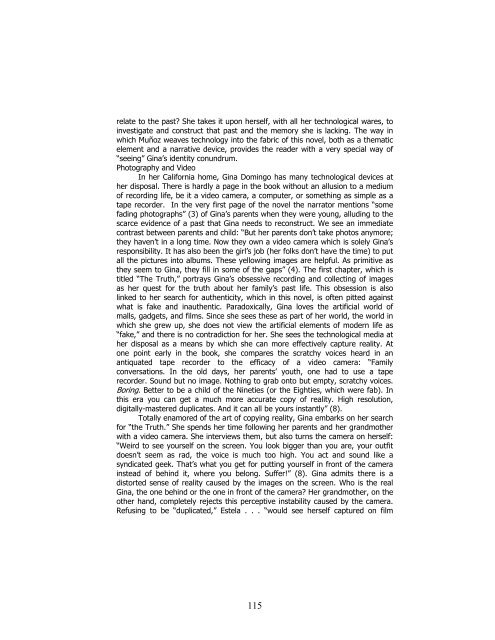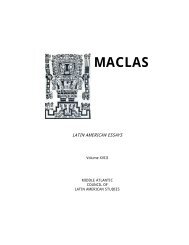latin american essays maclas
latin american essays maclas
latin american essays maclas
Create successful ePaper yourself
Turn your PDF publications into a flip-book with our unique Google optimized e-Paper software.
elate to the past She takes it upon herself, with all her technological wares, to<br />
investigate and construct that past and the memory she is lacking. The way in<br />
which Muñoz weaves technology into the fabric of this novel, both as a thematic<br />
element and a narrative device, provides the reader with a very special way of<br />
“seeing” Gina’s identity conundrum.<br />
Photography and Video<br />
In her California home, Gina Domingo has many technological devices at<br />
her disposal. There is hardly a page in the book without an allusion to a medium<br />
of recording life, be it a video camera, a computer, or something as simple as a<br />
tape recorder. In the very first page of the novel the narrator mentions “some<br />
fading photographs” (3) of Gina’s parents when they were young, alluding to the<br />
scarce evidence of a past that Gina needs to reconstruct. We see an immediate<br />
contrast between parents and child: “But her parents don’t take photos anymore;<br />
they haven’t in a long time. Now they own a video camera which is solely Gina’s<br />
responsibility. It has also been the girl’s job (her folks don’t have the time) to put<br />
all the pictures into albums. These yellowing images are helpful. As primitive as<br />
they seem to Gina, they fill in some of the gaps” (4). The first chapter, which is<br />
titled “The Truth,” portrays Gina’s obsessive recording and collecting of images<br />
as her quest for the truth about her family’s past life. This obsession is also<br />
linked to her search for authenticity, which in this novel, is often pitted against<br />
what is fake and inauthentic. Paradoxically, Gina loves the artificial world of<br />
malls, gadgets, and films. Since she sees these as part of her world, the world in<br />
which she grew up, she does not view the artificial elements of modern life as<br />
“fake,” and there is no contradiction for her. She sees the technological media at<br />
her disposal as a means by which she can more effectively capture reality. At<br />
one point early in the book, she compares the scratchy voices heard in an<br />
antiquated tape recorder to the efficacy of a video camera: “Family<br />
conversations. In the old days, her parents’ youth, one had to use a tape<br />
recorder. Sound but no image. Nothing to grab onto but empty, scratchy voices.<br />
Boring. Better to be a child of the Nineties (or the Eighties, which were fab). In<br />
this era you can get a much more accurate copy of reality. High resolution,<br />
digitally-mastered duplicates. And it can all be yours instantly” (8).<br />
Totally enamored of the art of copying reality, Gina embarks on her search<br />
for “the Truth.” She spends her time following her parents and her grandmother<br />
with a video camera. She interviews them, but also turns the camera on herself:<br />
“Weird to see yourself on the screen. You look bigger than you are, your outfit<br />
doesn’t seem as rad, the voice is much too high. You act and sound like a<br />
syndicated geek. That’s what you get for putting yourself in front of the camera<br />
instead of behind it, where you belong. Suffer!” (8). Gina admits there is a<br />
distorted sense of reality caused by the images on the screen. Who is the real<br />
Gina, the one behind or the one in front of the camera Her grandmother, on the<br />
other hand, completely rejects this perceptive instability caused by the camera.<br />
Refusing to be “duplicated,” Estela . . . “would see herself captured on film<br />
115




